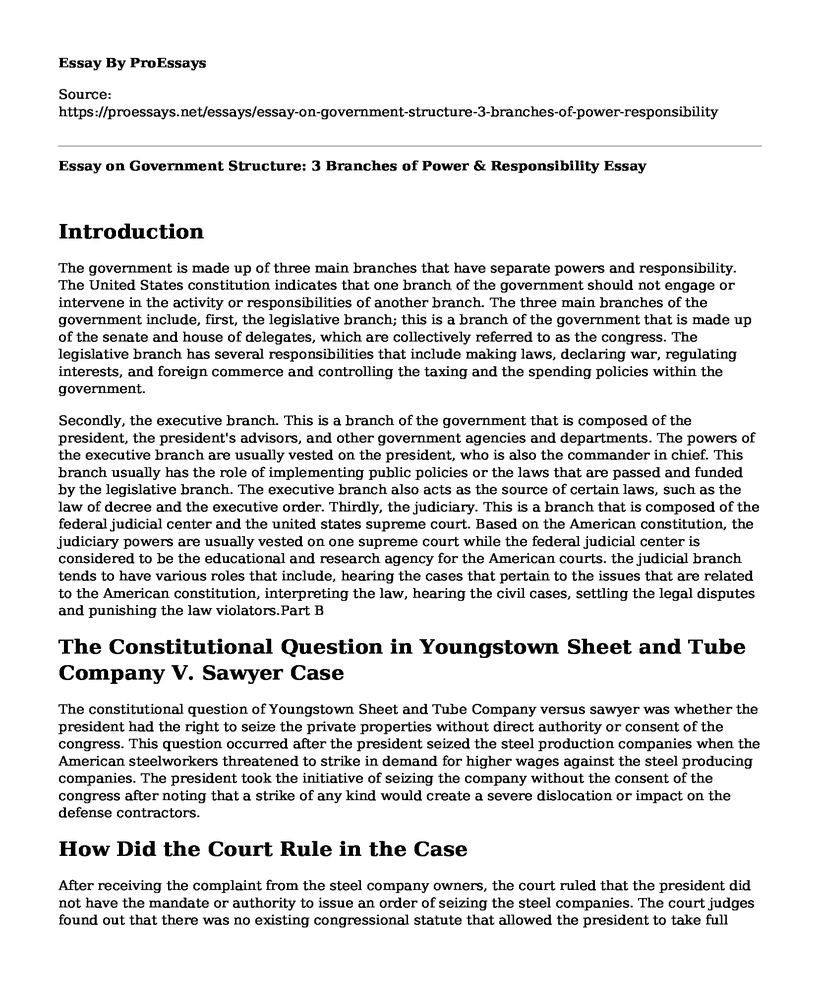Introduction
The government is made up of three main branches that have separate powers and responsibility. The United States constitution indicates that one branch of the government should not engage or intervene in the activity or responsibilities of another branch. The three main branches of the government include, first, the legislative branch; this is a branch of the government that is made up of the senate and house of delegates, which are collectively referred to as the congress. The legislative branch has several responsibilities that include making laws, declaring war, regulating interests, and foreign commerce and controlling the taxing and the spending policies within the government.
Secondly, the executive branch. This is a branch of the government that is composed of the president, the president's advisors, and other government agencies and departments. The powers of the executive branch are usually vested on the president, who is also the commander in chief. This branch usually has the role of implementing public policies or the laws that are passed and funded by the legislative branch. The executive branch also acts as the source of certain laws, such as the law of decree and the executive order. Thirdly, the judiciary. This is a branch that is composed of the federal judicial center and the united states supreme court. Based on the American constitution, the judiciary powers are usually vested on one supreme court while the federal judicial center is considered to be the educational and research agency for the American courts. the judicial branch tends to have various roles that include, hearing the cases that pertain to the issues that are related to the American constitution, interpreting the law, hearing the civil cases, settling the legal disputes and punishing the law violators.Part B
The Constitutional Question in Youngstown Sheet and Tube Company V. Sawyer Case
The constitutional question of Youngstown Sheet and Tube Company versus sawyer was whether the president had the right to seize the private properties without direct authority or consent of the congress. This question occurred after the president seized the steel production companies when the American steelworkers threatened to strike in demand for higher wages against the steel producing companies. The president took the initiative of seizing the company without the consent of the congress after noting that a strike of any kind would create a severe dislocation or impact on the defense contractors.
How Did the Court Rule in the Case
After receiving the complaint from the steel company owners, the court ruled that the president did not have the mandate or authority to issue an order of seizing the steel companies. The court judges found out that there was no existing congressional statute that allowed the president to take full possession of the private properties. The court also ruled that the president's power or role as a commander in chief at that particular time did not extend further to the labor disputes. Therefore, the court concluded and agreed that the president's power to ensure that the laws are properly executed tends to refute the idea that he can be a lawmaker.
How the Case Illustrates the Constitutional Principles of Separation of Powers
The case illustrated the principle of separation of power by indicating that, despite the president's superiority as the commander in chief of the armed forces, he cannot perform all obligations. He only has to stick to his role of being commander in chief and leave the role of making laws to other government branches. Therefore, each government branch tends to have separate responsibilities that cannot be shared.
Cite this page
Essay on Government Structure: 3 Branches of Power & Responsibility. (2023, Mar 02). Retrieved from https://proessays.net/essays/essay-on-government-structure-3-branches-of-power-responsibility
If you are the original author of this essay and no longer wish to have it published on the ProEssays website, please click below to request its removal:
- Events that Led to DOJ Oversight in the Form of a Consent Agreement
- Preemptive Attack Against North Korea and Possible Trump's Response - Essay Sample
- Essay Example on Congo Crisis: Hostility, Corruption, Poverty
- Pereboom's Libertarian Account for Human Choices: Bridging the Gap - Essay Sample
- Essay on Reforming the American Juvenile System: Economic, Social, and Racial Discrepancies
- Personal Jurisdiction: Court's Power to Decide On the Person Being Sued - Essay Sample
- Human or Civil Rights: Relevant & Contemporary - Essay Sample







